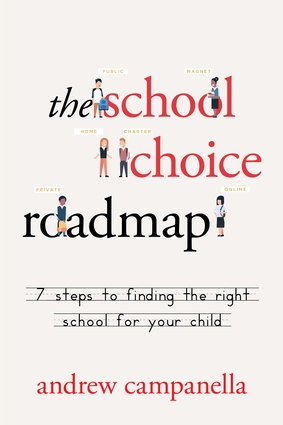The School Choice Roadmap
7 Steps to Finding the Right School for Your Child
- 2020 INDIES Winner
- Gold, Education (Adult Nonfiction)
With a convincing platform that’s based on helping children thrive, The School Choice Roadmap is a fair-minded resource.
A reassuring guide for parents, Andrew Campanella’s The School Choice Roadmap is all about navigating the sometimes overwhelming decisions around K-12 enrollment.
Its outlook positive, the book emphasizes the idea that school choice is personal, not political. It sidesteps the public versus private school debate, suggesting that parents research the options that are available where they live. What matters, it asserts, is what’s best for each individual student; it argues that parents are the experts when it comes to knowing their kids.
Presented in two parts, the book first forwards an objective overview of six types of schools: traditional public, public charter, public magnet, online public, private, and home. It argues the potential benefits of each, discussing the facts in a friendly way that’s appreciative of how busy parents are. This section will be helpful for cutting through school mission statements and numerical ratings to evaluate the key features which are relevant to a family’s circumstances. Its information sticks to standard definitions. In its second portion, the book outlines seven steps toward choosing a school.
Because of its neutral stance, the book does not meditate on the potential drawbacks of each type of school. Its anecdotes favor successful school placements, and it does not spend much time exploring how to select a school that complements the different ways that children learn, from visual-spatial learning to kinesthetic learning, though these impact success in any given classroom. Special needs and gifted students are addressed but are not a point of focus.
Encouraging parents to take confident, active roles in shaping their children’s academic experiences, the book presumes a somewhat level field. Rural locales, economic issues, and other factors that impact school decisions are underevaluated. Some gaps are addressed with resources for those seeking scholarships and a list of websites for further advocacy. A frequently asked questions list addresses situations such as transferring not being an option, and the book suggests ways for parents to make their children’s current schools better.
The book features some noteworthy schools from across the nation, from schools that are steeped in language immersion, STEM, or the arts to those that focus on college preparation or special needs. These examples demonstrate that good schools can be found in many settings, both public and private. Quotes from parents and educators reiterate the importance of considering each child’s unique makeup to find a good fit, and they represent a variety of perspectives. Helpful charts depict potential choices across fifty states.
When it comes to deciding, the book’s clarifying worksheets are designed to help. They center on thinking about personal values, urging parents to recall the pros and cons of their own school experiences and to consider their children’s interests and strengths. Such reflective exercises are helpful for focusing one’s personal criteria. Practical information, including a list of questions to ask on school tours, takes away some of the anxiety about picking the “right” place.
The School Choice Roadmap distills American educational options for busy parents, whom it encourages to look beyond one-size-fits-all thinking. With a convincing platform that’s based on helping children thrive, this is a fair-minded resource.
Reviewed by
Karen Rigby
Disclosure: This article is not an endorsement, but a review. The publisher of this book provided free copies of the book and paid a small fee to have their book reviewed by a professional reviewer. Foreword Reviews and Clarion Reviews make no guarantee that the publisher will receive a positive review. Foreword Magazine, Inc. is disclosing this in accordance with the Federal Trade Commission’s 16 CFR, Part 255.

